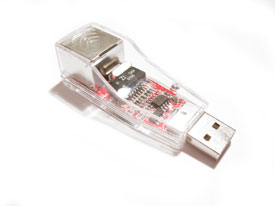USB Repeater - This will convert the USB signal into another signal, transmit it over some medium such as Cat 5, Wireless (802.11g), or Fiber Optic. Those are the most common methods, anyway.
(Pictured: 1600ft USB Fiber Optic Repeater)
USB Extender - This will extend your USB port to a remote location, without converting your signal.

(Pictured: 65ft USB 2.0 Extension Cable)
So, your first question would probably be: What do I care if it converts it or not? For some, it won't make any difference at all. For others, it won't work. USB, when pushed to it's limits, functionality can be sporadic. Let me give you an example: While working in the copier and scanner industry, I had to connect what's called a "wide format scanner". The wide format scanner is used in architectural firms to scan in their large drawings for archiving. I decided a great idea would be to extend it, since it was about 20ft away (USB specs a maximum cable distance of 15ft). This posed a problem, but I knew at the time that USB Active extensions were widely available. I connected it, the computer recognized it, ran test scans, and everything looked great! No problems showed up until the next day. I got a call back from the client saying they couldn't scan. After going out there, I found that it said "USB Device not recognized". Immediately I realized what the problem was: There wasn't enough power being put through to the scanner. So, I ran over to the local computer store (at the time, CompUSA) and picked up a powered USB hub. Immediately I went back to the client. Sure enough, my theory was right, there wasn't enough power.
So, what does this all mean? It means that when USB is pushed past it's limits, it needs to be with forethought. I've seen a growing number of USB repeaters (normally over Cat 5) and have tested many personally. I noticed that some work, and some don't. Most of the new things out there are modeled after our USB Repeater - Home Edition - it's an inexpensive repeater that works for some home uses, but that's just the beginning of it.
To help make comparison easy, we've creating a couple of charts to help you.
1.) Here's a chart to help you compare USB 1.1 Repeaters and Extenders
2.) Here's a chart to help you compare Hi-Speed USB 2.0 Repeaters and Extenders
This should at least get you started. If you have more questions, post them, or go to our website: www.USBFireWire.com



